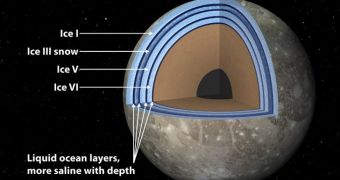Just yesterday, the National Aeronautics and Space Administration in the United States, better known as NASA, announced that, according to evidence at hand, it might be that a so-called club sandwich of oceans and ice is part and parcel of the makeup of Ganymede.
For those who are not all that familiar with space exploration, Ganymede is a satellite to Jupiter and has been documented to be the largest moon in the Solar System. Thus, its diameter is said to measure about 5,268 kilometers (3,273 miles).
On its website, NASA explains that scientists first started thinking about the possibility that Ganymede accommodates for an ocean stacked between two layers of ice back in the 1970s. Sometime after, in the 1990s, the Galileo mission confirmed these suspicions.
More precisely, it showed that the ocean on this satellite of Jupiter extends to depths of hundreds of miles and that salty seas, probably containing the compound magnesium sulfate, are also present on this moon, NASA details.
While carrying out a series of experiments, researcher Steve Vance and his colleagues found that, depending on pressure, salt can change the properties of a given liquid. Specifically, it appears that, under extreme conditions such as the ones inside Ganymede, salt greatly increases the density of liquids.
The scientists further explain that, as shown by previous studies, the same extreme conditions cause ice crystal structures to become more compact, simply because they force ice molecules to become packed together quite tightly. The resulting ice is very dense and, consequently, heavy.
Based on this information, Steve Vance and fellow researchers came up with a new model for the makeup of Ganymede. This model, pictured above, comprises layers of ice and oceans that sit on top of one another much like the ingredients of a club sandwich.
Of these layers, the one above is made up of the lightest ice, and the one at the bottom is made up of liquid that is salty and heavy enough to sink, the scientists explain. A rocky seafloor that sits under this last layer of ocean need also be taken into consideration.
“This is good news for Ganymede. Its ocean is huge, with enormous pressures, so it was thought that dense ice had to form at the bottom of the ocean. When we added salts to our models, we came up with liquids dense enough to sink to the sea floor,” Steve Vance said in a statement.
“Ganymede's ocean might be organized like a Dagwood sandwich,” the scientist summed up his and his colleagues' findings, a detailed account of which is available in a recent issue of the journal Planetary and Space Science.
Interestingly enough, the researchers say that, since places where water and rock interact are important for the development of life, it is possible that Ganymede harbors life in its inner oceans.

 14 DAY TRIAL //
14 DAY TRIAL //